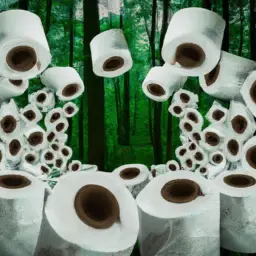I’ve always thought toilet paper was harmless, until I discovered the eye-opening truth about its environmental footprint.
In this article, I’ll reveal the shocking carbon emissions, deforestation crisis, water waste, and hidden dangers of chemicals caused by conventional TP.
Prepare to be astonished as we delve into the dark side of something as simple as toilet paper.
It’s time to rethink our choices and make more sustainable decisions for the planet.
The Environmental Impact of Conventional Toilet Paper

Discussing the environmental impact of conventional toilet paper is essential in understanding its true implications. When we think about the amount of toilet paper we use on a daily basis, it becomes clear that our reliance on this single-use product is taking a toll on the environment. But are there alternatives to conventional toilet paper that are more sustainable?
The answer is yes. Toilet paper alternatives have gained popularity in recent years as people become more conscious of their environmental footprint. These alternatives include bamboo toilet paper, which is made from a renewable resource that grows quickly and doesn’t require harmful pesticides or fertilizers. Another option is recycled toilet paper, which is made from post-consumer waste paper, reducing the demand for virgin wood pulp.
In addition to these alternatives, sustainable bathroom solutions are also worth considering. Installing bidets or bidet attachments can significantly reduce the amount of toilet paper used, as they provide a more hygienic and water-efficient cleaning method. Furthermore, reusable cloth wipes can be used instead of toilet paper, which not only reduces waste but also saves money in the long run.
Understanding the Carbon Footprint of Traditional TP

How does the carbon footprint of traditional TP contribute to environmental degradation?
When it comes to the carbon emissions associated with traditional toilet paper, the numbers are quite staggering. The production and distribution of conventional TP contribute significantly to greenhouse gas emissions, primarily through the use of fossil fuels in the manufacturing process and transportation. The extraction of raw materials, such as wood pulp, requires energy-intensive processes that release carbon dioxide into the atmosphere. Additionally, the transportation of toilet paper from the manufacturing facilities to retailers and consumers further adds to its carbon footprint.
To address this issue, sustainability measures are being implemented by some companies in the toilet paper industry. These include using recycled materials, such as post-consumer waste, instead of virgin fibers, which reduces the need for deforestation and the associated carbon emissions. Additionally, some companies are adopting renewable energy sources, such as solar or wind power, to power their manufacturing facilities, further reducing their carbon footprint.
Understanding the carbon footprint of traditional TP is crucial in realizing the environmental impact it has. By promoting sustainable practices and supporting companies that prioritize reducing their carbon emissions, we can contribute to a healthier planet and a more sustainable future.
The Deforestation Crisis Caused by Traditional Toilet Paper

As a writer, I’m concerned about the deforestation crisis caused by traditional toilet paper, and it’s essential to shed light on this issue.
The production of traditional toilet paper involves cutting down millions of trees every year, leading to a significant loss of forests globally. This deforestation crisis has severe consequences for our environment and ecosystem.
Forests play a crucial role in regulating the Earth’s climate by absorbing carbon dioxide and releasing oxygen. When trees are cut down to produce toilet paper, not only are we losing valuable carbon sinks, but we’re also releasing stored carbon back into the atmosphere, contributing to climate change. Additionally, deforestation destroys habitats for countless species, leading to biodiversity loss and ecosystem imbalance.
Fortunately, there are sustainable alternatives to traditional toilet paper that can help mitigate this crisis. One such alternative is bamboo toilet paper. Bamboo is a fast-growing plant that can be harvested sustainably without causing deforestation. It requires no pesticides or fertilizers and can be grown without depleting soil nutrients.
Switching to bamboo toilet paper can significantly reduce our reliance on tree-based products and help protect our forests.
Water Waste: How Traditional TP Contributes to the Problem

Addressing the issue of water waste, traditional TP contributes to the problem by requiring excessive amounts of water for production and causing strain on water resources. When we think of toilet paper, we often overlook the significant amount of water that goes into its manufacturing process. From the cultivation of trees to the pulping and bleaching stages, water is used at every step. In fact, it takes approximately 37 gallons of water to produce a single roll of traditional toilet paper.
This water-intensive production process not only depletes water resources but also contributes to water pollution. The chemicals used in the bleaching process can contaminate waterways, harming aquatic ecosystems and compromising water quality. Moreover, the excessive water consumption exacerbates water scarcity issues, particularly in regions already facing water stress.
To address this problem, it’s crucial to consider toilet paper alternatives and sustainable bathroom solutions. One such alternative is bamboo toilet paper, which requires significantly less water to grow compared to traditional tree-based TP. Additionally, recycled toilet paper made from post-consumer waste reduces the need for virgin materials and conserves water resources.
The Hidden Dangers of Chemicals in Conventional Toilet Paper

I’ve discovered that there are numerous hidden dangers associated with the chemicals found in conventional toilet paper. Many people are unaware of the toxic ingredients that are present in the toilet paper they use every day. These chemicals can pose serious health risks and should not be taken lightly.
One of the main culprits is chlorine, which is used in the bleaching process of toilet paper production. Chlorine can release harmful compounds called dioxins, which have been linked to various health problems, including cancer and reproductive disorders. Another common chemical found in conventional toilet paper is formaldehyde, a known carcinogen that can cause respiratory issues and allergic reactions.
To highlight the dangers of these chemicals, let’s take a look at the following table:
| Chemical | Health Risks | Common Uses |
|---|---|---|
| Chlorine | – Cancer | |
| – Reproductive disorders | Bleaching process | |
| Formaldehyde | – Respiratory issues | |
| – Allergic reactions | Preservative | |
| Fragrances | – Skin irritation | |
| – Hormone disruption | Scent masking |
As you can see, the toxic ingredients in conventional toilet paper can have serious consequences for our health. It is essential to be aware of these risks and consider alternatives that prioritize our well-being. Switching to eco-friendly toilet paper made from recycled materials or bamboo can help minimize our exposure to these harmful chemicals and contribute to a healthier environment.
Conclusion
In conclusion, it’s evident that conventional toilet paper has a significant and detrimental environmental footprint. From its carbon emissions to deforestation and water waste, traditional TP contributes to the problems our planet faces today.
Additionally, the hidden dangers of chemicals in these products raise concerns for both our health and the environment.
It’s crucial for individuals and society as a whole to be aware of these issues and consider more sustainable alternatives for a greener future.


